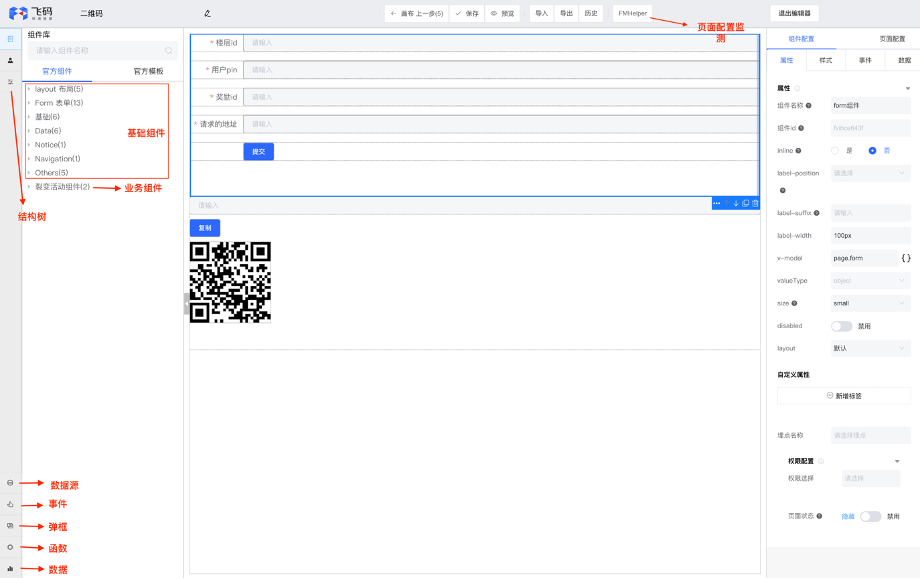reduce 是 JavaScript 数组对象上的一个高阶函数
它可以用来迭代数组中的所有元素,并返回一个单一的值。
其常用的语法为: array.reduce(callback[, initialValue])
其中,callback 是一个回调函数,它接受四个参数:累加器(初始值或上一次回调函数的返回值)、当前元素、当前索引、操作的数组本身。initialValue 是一个可选的初始值,如果提供了该值,则作为累加器的初始值,否则累加器的初始值为数组的第一个元素。 reduce 函数会从数组的第一个元素开始,依次对数组中的每个元素执行回调函数。回调函数的返回值将成为下一次回调函数的第一个参数(累加器)。最后,reduce 函数返回最终的累加结果。 以下是一个简单的 reduce 示例,用于计算数组中所有元素的和:
const arr = [1, 2, 3, 4, 5]; const sum = arr.reduce((accumulator, currentValue) => accumulator + currentValue); console.log(sum); // 15
在上面的代码中,reduce 函数从数组的第一个元素开始,计算累加值,返回最终的累加结果 15。 除了数组的求和,reduce 函数还可以用于其他各种用途,如数组求平均数、最大值、最小值等。此外,reduce 函数还可以与 map、filter、forEach 等函数组合使用,实现更加复杂的数据操作。
当然,以下是一些 reduce 的实际应用案例,帮助你更好地理解它的用法:
计算数组的平均数
const arr = [1, 2, 3, 4, 5];
const average = arr.reduce((accumulator, currentValue, index, array) => {
accumulator += currentValue;
if (index === array.length - 1) {
return accumulator / array.length;
} else {
return accumulator;
}
});
console.log(average); // 3
求数组的最大值
const arr = [1, 2, 3, 4, 5]; const max = arr.reduce((accumulator, currentValue) => Math.max(accumulator, currentValue)); console.log(max); // 5
求数组的最小值
const arr = [1, 2, 3, 4, 5]; const min = arr.reduce((accumulator, currentValue) => Math.min(accumulator, currentValue)); console.log(min); // 1
数组去重
const arr = [1, 2, 3, 3, 4, 4, 5];
const uniqueArr = arr.reduce((accumulator, currentValue) => {
if (!accumulator.includes(currentValue)) {
accumulator.push(currentValue);
}
return accumulator;
}, []);
console.log(uniqueArr); // [1, 2, 3, 4, 5]
计算数组中每个元素出现的次数
const arr = [1, 2, 3, 3, 4, 4, 5];
const countMap = arr.reduce((accumulator, currentValue) => {
if (!accumulator[currentValue]) {
accumulator[currentValue] = 1;
} else {
accumulator[currentValue]++;
}
return accumulator;
}, {});
console.log(countMap); // {1: 1, 2: 1, 3: 2, 4: 2, 5: 1}
实现数组分组
const arr = [1, 2, 3, 4, 5];
const result = arr.reduce((accumulator, currentValue) => {
if (currentValue % 2 === 0) {
accumulator.even.push(currentValue);
} else {
accumulator.odd.push(currentValue);
}
return accumulator;
}, { even: [], odd: [] });
console.log(result); // {even: [2, 4], odd: [1, 3, 5]}
计算数组中连续递增数字的长度
const arr = [1, 2, 3, 5, 6, 7, 8, 9];
const result = arr.reduce((accumulator, currentValue, index, array) => {
if (index === 0 || currentValue !== array[index - 1] + 1) {
accumulator.push([currentValue]);
} else {
accumulator[accumulator.length - 1].push(currentValue);
}
return accumulator;
}, []);
const maxLength = result.reduce((accumulator, currentValue) => Math.max(accumulator, currentValue.length), 0);
console.log(maxLength); // 5
计算对象数组的属性总和
const arr = [
{ name: 'Alice', age: 25 },
{ name: 'Bob', age: 30 },
{ name: 'Charlie', age: 35 },
];
const result = arr.reduce((accumulator, currentValue) => accumulator + currentValue.age, 0);
console.log(result); // 90
将对象数组转换为键值对对象
const arr = [
{ name: 'Alice', age: 25 },
{ name: 'Bob', age: 30 },
{ name: 'Charlie', age: 35 },
];
const result = arr.reduce((accumulator, currentValue) => {
accumulator[currentValue.name] = currentValue.age;
return accumulator;
}, {});
console.log(result); // {Alice: 25, Bob: 30, Charlie: 35}
计算数组中出现次数最多的元素
const arr = [1, 2, 3, 4, 4, 4, 5, 5, 6, 6, 6, 6];
const result = arr.reduce((accumulator, currentValue) => {
accumulator[currentValue] = (accumulator[currentValue] || 0) + 1;
return accumulator;
}, {});
const maxCount = Math.max(...Object.values(result));
const mostFrequent = Object.keys(result).filter(key => result[key] === maxCount).map(Number);
console.log(mostFrequent); // [6]
实现 Promise 串行执行
const promise1 = () => Promise.resolve('one');
const promise2 = (input) => Promise.resolve(input + ' two');
const promise3 = (input) => Promise.resolve(input + ' three');
const promises = [promise1, promise2, promise3];
const result = promises.reduce((accumulator, currentValue) => {
return accumulator.then(currentValue);
}, Promise.resolve('start'));
result.then(console.log); // 'one two three'
对象属性值求和
const obj = {
a: 1,
b: 2,
c: 3
};
const result = Object.values(obj).reduce((accumulator, currentValue) => accumulator + currentValue);
console.log(result); // 6
按属性对数组分组
const arr = [
{ id: 1, name: 'John' },
{ id: 2, name: 'Mary' },
{ id: 3, name: 'Bob' },
{ id: 4, name: 'Mary' }
];
const result = arr.reduce((accumulator, currentValue) => {
const key = currentValue.name;
if (!accumulator[key]) {
accumulator[key] = [];
}
accumulator[key].push(currentValue);
return accumulator;
}, {});
console.log(result);
/*
{
John: [{ id: 1, name: 'John' }],
Mary: [
{ id: 2, name: 'Mary' },
{ id: 4, name: 'Mary' }
],
Bob: [{ id: 3, name: 'Bob' }]
}
*/
扁平化数组
// 如果你有一个嵌套的数组,可以使用reduce将其扁平化成一个一维数组。例如: const nestedArray = [[1, 2], [3, 4], [5, 6]]; const flattenedArray = nestedArray.reduce((acc, curr) => acc.concat(curr), []); console.log(flattenedArray); // [1, 2, 3, 4, 5, 6]
合并对象
// 可以使用reduce将多个对象合并成一个对象。例如:
const obj1 = { a: 1, b: 2 };
const obj2 = { c: 3, d: 4 };
const obj3 = { e: 5, f: 6 };
const mergedObj = [obj1, obj2, obj3].reduce((acc, curr) => Object.assign(acc, curr), {});
console.log(mergedObj); // {a: 1, b: 2, c: 3, d: 4, e: 5, f: 6}以上就是JavaScript数组对象高阶函数reduce的妙用详解的详细内容,更多关于JavaScript数组对象reduce的资料请关注其它相关文章!
原文地址:https://juejin.cn/post/7223278436893163581
版权声明:除特别声明外,本站所有文章皆是本站原创,转载请以超链接形式注明出处!








